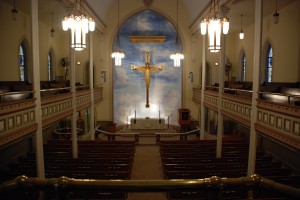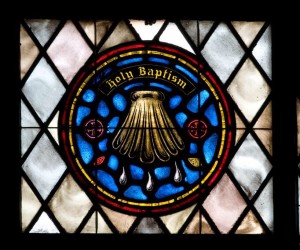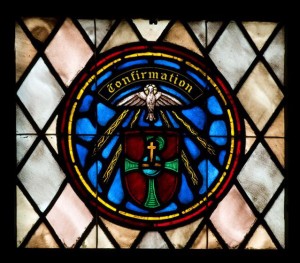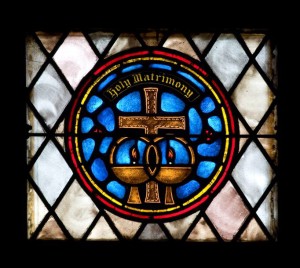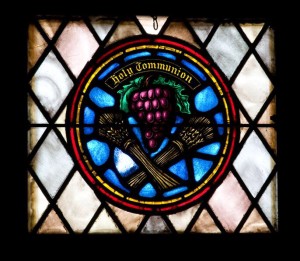Symbols at St. Andrew
Symbols of St. Andrew Lutheran Church
The Cross
The cross in the altar chancel is known as the “Christus Rex” or kingly Christ denoting the resurrected and ascended Christ. Therefore, His hands and feet are not nailed to the cross, and his body is covered with a kingly robe.
Symbols on the four ends of the cross represent the four Evangelists.
In Matthew the manhood of the nature of Christ is stressed – a winged man.
In Mark the power and miracles of the Savior are emphasized – a winged lion – a symbol of strength.
In Luke the winged ox as a symbol of sacrifice is assigned to Luke because of his many references to the sacrifice and atonement of the Savior.
In John the eagle is the symbol of John, the Evangelist, because he reaches greater heights of revelation than any other.
The Altar
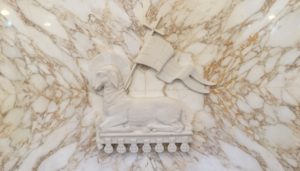
On the altar you see the “Agnus Dei”, Latin for the Lamb of God. The banner is the banner of victory.
Seven Candles
Seven candles on each side of the altar represent the Seven gifts of the Holy Spirit; Spirit, Wisdom, Understanding, Counsel, Might, Knowledge, and Fear of God.
The Windows – Downstairs
Baptism – The escallop shell is used for baptism. Pictures exist showing John the Baptist pouring water from a shell upon the head of our Savior, who stands knee deep in the waters of the Jordan. The three drops of water indicate the threefold use of the names of the three persons in the Blessed Trinity.
Confirmation – The descending dove, symbolic of the Holy Spirit, has been used as a sign for confirmation because of the blessing of the confirmand; “God the Father of our Lord Jesus Christ, give you His Holy Spirit, etc.” Here the Dove of the Spirit is shown over the “Shield of Faith” (Eph. 6:16) on which is seen the symbol of Christ, the author and finisher of our faith.
Holy Matrimony – The Cross (symbol of the Savior) signifies His blessing on the two rings emblem of the plighted troth, while the candles symbolize the light of a new home.
Holy Communion – The symbol takes its origin from the bread prepared of wheat, and the wine, the fruit of the vine used in preparing the visible elements for the Holy Supper.
Symbols on the Lord’s Prayer
“OUR FATHER WHICH ART IN HEAVEN” – The creating providing hand of God, the Father, extends out of a fleecy cloud. On top is the sun, to the left and right, the stars and the moon. The circle around God’s hand symbolizes eternity and the three rays within the circle symbolizes the Trinity again.
“HALLOWED BE THY NAME” – The triangle, a popular symbol of the Triune God, is set on the blazing dias of the glorifying of God’s Name. The Hebrew characters on the triangle read, “Jehovah,” one of God’s names.
“THY KINGDOM COME” – The Christian Church is often symbolized as a ship. Here it is represented by a two masted brigantine of the 17th and 18th centuries. It rolls over the waves to the “port of human entry.” A Greek cross on the sail identifies the ship.
“THY WILL BE DONE ON EARTH, AS IT IS IN HEAVEN.” – An angel kneeling on a pedestal with hands pointing heavenward in prayer, represents the will of God done in heaven. It is the symbol of perfect obedience to which the Christian adds, “So be it on earth.”
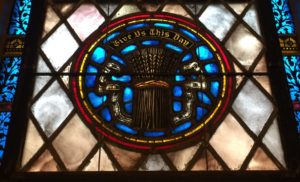
“GIVE US THIS DAY OUR DAILY BREAD.” – Full, rich kernels of wheat, fresh from the harvest, are bound together by a ribbon, symbolizing the full richness and divine providence of God in physical needs. Seven, a common Bible numeral, is the number of stalks.
“FORGIVE US OUR TRESPASSES, AS WE FORGIVE THOS WHO TRESPASS AGAINST US.” – The Ten Commandments, divided into Two Tablets of love towards God and love towards our neighbor, have been broken and marred by man’s trespasses. The Christian prayer for God’s forgiveness and asks ability to forgive.
“AND LEAD US NOT INTO TEMPTATION” – Pictured as a rattlesnake, the tempter, Satan has invaded and infests and surrounds the world, which is beset by “temptation” itself.
“BUT DELIVER US FROM EVIL” – Glowering clouds, a jagged streak of lightning, a turbulent sea endanger the frail life of the ship of life, sailing on the horizon. The ship is riding out the storm with its sails reeded.
Balcony – Symbols of Apostles
Peter – The crossed keys recall Peter’s confession and our Lord’s statement regarding the Office of the Keys. (Matt 16: 13-19) Peter is said to have been crucified head downward, for he did not consider himself worthy to die in the same position as that of his Lord. Therefore the inverted cross.
James the Greater – The usual form of this apostle’s shield shows the escallop shells. The escallop shell is the symbol of pilgrimage. Hence the shells are an emblem of the travels of James.
John – An attempt was made to slay this apostle by giving him a poisoned chalice. Hence the chalice and serpent.
Andrew – This symbol shows two fishes crossed, recalling his original occupation, and his call to become a fisher of men.
Philip – This symbol reminds us of Philip’s answer to the Lord, John 6:7, and also the statement in Verse 13, in the story of the Feeding of the Five Thousand.
Bartholomew – This apostle is said to have been flayed alive for the Gospel. Hence the open Bible and flaying knife.
Thomas – This apostle is said to have built a church with his own hands in India (therefore the square) and to have been shot down with arrows and left flying until a pagan priest ran him through with a spear.
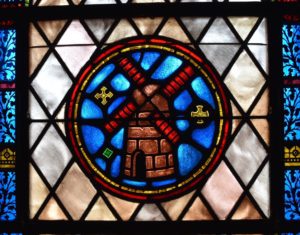
James the Minor – A windmill is driven by wind, therefore, this represents James the Minor. Compare James 3:4.
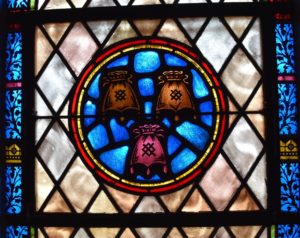
Matthew – This apostle has three money bags assigned as his emblem because he was a tax gatherer when Jesus called him.
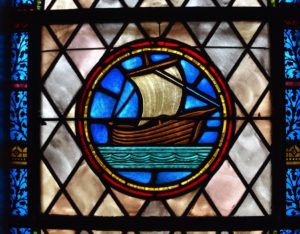
Jude – This apostle, also called Thaddaeus and Lebacus, was a tireless missionary, having visited Arabia, Syria, and Mesopotamia. Hence he is given a sail-boat with a cross shaped mast as his emblem.
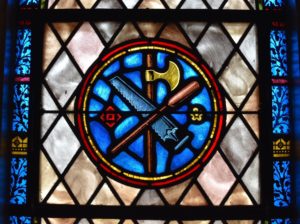
Simon – He was the companion of Jude on many of his missionary tours (therefore the oar). It is generally supposed that he was beheaded, hence the battle-axe, and then sawn asunder (hence the saw).
Matthias – This apostle was chosen to take the place of Judas. It is said the he was beheaded for the Gospel’s sake. Hence the Bible and halberd.

